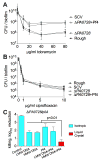Filamentous Bacteriophage Promote Biofilm Assembly and Function
- PMID: 26567508
- PMCID: PMC4653043
- DOI: 10.1016/j.chom.2015.10.013
Filamentous Bacteriophage Promote Biofilm Assembly and Function
Abstract
Biofilms-communities of bacteria encased in a polymer-rich matrix-confer bacteria with the ability to persist in pathologic host contexts, such as the cystic fibrosis (CF) airways. How bacteria assemble polymers into biofilms is largely unknown. We find that the extracellular matrix produced by Pseudomonas aeruginosa self-assembles into a liquid crystal through entropic interactions between polymers and filamentous Pf bacteriophages, which are long, negatively charged filaments. This liquid crystalline structure enhances biofilm function by increasing adhesion and tolerance to desiccation and antibiotics. Pf bacteriophages are prevalent among P. aeruginosa clinical isolates and were detected in CF sputum. The addition of Pf bacteriophage to sputum polymers or serum was sufficient to drive their rapid assembly into viscous liquid crystals. Fd, a related bacteriophage of Escherichia coli, has similar biofilm-building capabilities. Targeting filamentous bacteriophage or the liquid crystalline organization of the biofilm matrix may represent antibacterial strategies.
Copyright © 2015 Elsevier Inc. All rights reserved.
Conflict of interest statement
The authors declare no conflict of interest.
Figures







Comment in
-
Biofilm assembly becomes crystal clear - filamentous bacteriophage organize the Pseudomonas aeruginosa biofilm matrix into a liquid crystal.Microb Cell. 2015 Dec 31;3(1):49-52. doi: 10.15698/mic2016.01.475. Microb Cell. 2015. PMID: 28357315 Free PMC article.
Similar articles
-
Biofilm assembly becomes crystal clear - filamentous bacteriophage organize the Pseudomonas aeruginosa biofilm matrix into a liquid crystal.Microb Cell. 2015 Dec 31;3(1):49-52. doi: 10.15698/mic2016.01.475. Microb Cell. 2015. PMID: 28357315 Free PMC article.
-
Study of the probability of resistance to phage infection in a collection of clinical isolates of Pseudomonas aeruginosa in relation to the presence of Pf phages.Microbiol Spectr. 2025 Mar 4;13(3):e0301024. doi: 10.1128/spectrum.03010-24. Epub 2025 Feb 5. Microbiol Spectr. 2025. PMID: 39907445 Free PMC article.
-
Characterization of the integrated filamentous phage Pf5 and its involvement in small-colony formation.Microbiology (Reading). 2007 Jun;153(Pt 6):1790-1798. doi: 10.1099/mic.0.2006/003533-0. Microbiology (Reading). 2007. PMID: 17526836 Free PMC article.
-
Pseudomonas aeruginosa Bacteriophages and Their Clinical Applications.Viruses. 2024 Jun 29;16(7):1051. doi: 10.3390/v16071051. Viruses. 2024. PMID: 39066214 Free PMC article. Review.
-
Pf Bacteriophage and Their Impact on Pseudomonas Virulence, Mammalian Immunity, and Chronic Infections.Front Immunol. 2020 Feb 21;11:244. doi: 10.3389/fimmu.2020.00244. eCollection 2020. Front Immunol. 2020. PMID: 32153575 Free PMC article. Review.
Cited by
-
Methods for Extraction and Detection of Pf Bacteriophage DNA from the Sputum of Patients with Cystic Fibrosis.Phage (New Rochelle). 2020 Jun 1;1(2):100-108. doi: 10.1089/phage.2020.0003. Epub 2020 Jun 16. Phage (New Rochelle). 2020. PMID: 32626852 Free PMC article.
-
Pf Filamentous Phage Requires UvrD for Replication in Pseudomonas aeruginosa.mSphere. 2016 Feb 10;1(1):e00104-15. doi: 10.1128/mSphere.00104-15. eCollection 2016 Jan-Feb. mSphere. 2016. PMID: 27303696 Free PMC article.
-
Polyamines and linear DNA mediate bacterial threat assessment of bacteriophage infection.Proc Natl Acad Sci U S A. 2023 Feb 28;120(9):e2216430120. doi: 10.1073/pnas.2216430120. Epub 2023 Feb 21. Proc Natl Acad Sci U S A. 2023. PMID: 36802441 Free PMC article.
-
Lying in Wait: Modeling the Control of Bacterial Infections via Antibiotic-Induced Proviruses.mSystems. 2019 Oct 1;4(5):e00221-19. doi: 10.1128/mSystems.00221-19. mSystems. 2019. PMID: 31575664 Free PMC article.
-
The Immune Response to Chronic Pseudomonas aeruginosa Wound Infection in Immunocompetent Mice.Adv Wound Care (New Rochelle). 2020 Feb 1;9(2):35-47. doi: 10.1089/wound.2019.1039. Epub 2019 Dec 18. Adv Wound Care (New Rochelle). 2020. PMID: 31903297 Free PMC article.
References
-
- Asakura S, Oosawa F. Interaction between Particles Suspended in Solutions of Macromolecules. J Polym Sci. 1958;33:183–192.
-
- Costerton JW, Stewart PS, Greenberg EP. Bacterial biofilms: a common cause of persistent infections. Science. 1999;284:1318–1322. - PubMed
Publication types
MeSH terms
Substances
Grants and funding
LinkOut - more resources
Full Text Sources
Other Literature Sources
Molecular Biology Databases

